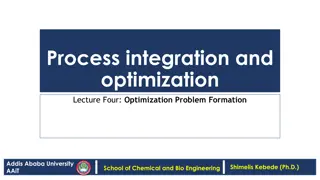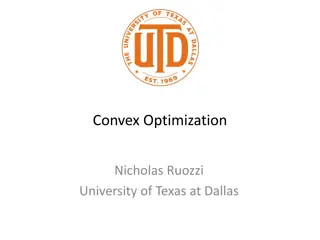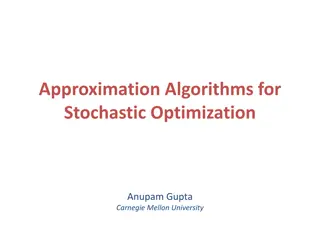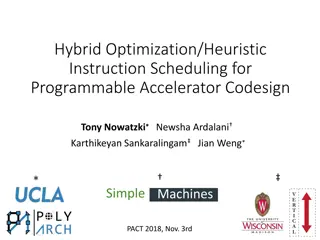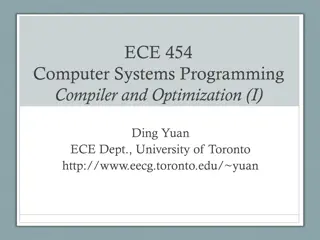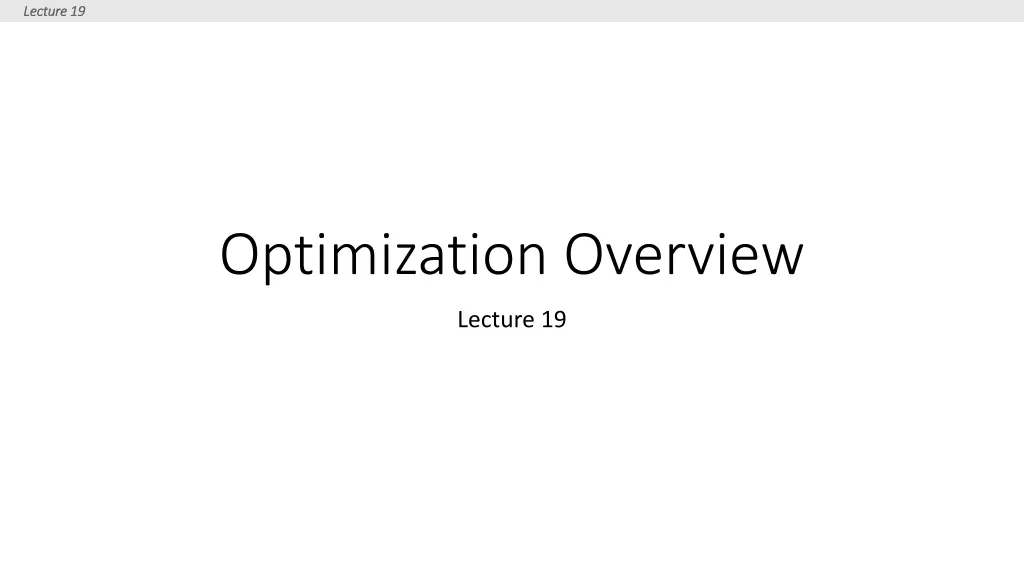
SQL Query Optimization Techniques Overview
Learn about logical and physical optimization of SQL queries, the differences between them, and how relational algebra plans play a crucial role in optimizing query performance. Explore the process of finding efficient plans, minimizing tuple counts, and executing optimized plans in SQL engines.
Download Presentation

Please find below an Image/Link to download the presentation.
The content on the website is provided AS IS for your information and personal use only. It may not be sold, licensed, or shared on other websites without obtaining consent from the author. If you encounter any issues during the download, it is possible that the publisher has removed the file from their server.
You are allowed to download the files provided on this website for personal or commercial use, subject to the condition that they are used lawfully. All files are the property of their respective owners.
The content on the website is provided AS IS for your information and personal use only. It may not be sold, licensed, or shared on other websites without obtaining consent from the author.
E N D
Presentation Transcript
Lecture 19 Lecture 19 Optimization Overview Lecture 19
Lecture 19 Lecture 19 Announcements B+Tree Project: Push push push You still have have one full weekend! Last out of 4 full weekends. Make it count! Note on previous lectures : Derive don t memorize. E.g., 3(P(R) + P(S)) + OUT I really do not want you to memorize this formula I really want you to be able to derive it! Final. Room announced: NOLAND 132 (Dec 20th 2:45 pm 4:45 pm)
Lecture 19 Lecture 19 Today s Lecture 1. Logical Optimization 2. Physical Optimization 3
Lecture 19 Lecture 19 SQL Query Logical vs. Physical Optimization Relational Algebra (RA) Plan Logical optimization: Find equivalent plans that are more efficient Intuition: Minimize # of tuples at each step by changing the order of RA operators Optimized RA Plan Physical optimization: Find algorithm with lowest IO cost to execute our plan Intuition: Calculate based on physical parameters (buffer size, etc.) and estimates of data size (histograms) Execution
Lecture 19 > Section Lecture 19 > Section 1 1 1. Logical Optimization 5
Lecture 19 > Section Lecture 19 > Section 1 1 What you will learn about in this section 1. Optimization of RA Plans 2. ACTIVITY: RA Plan Optimization 6
Lecture 19 > Section Lecture 19 > Section 1 1 > Plan Optimization > Plan Optimization RDBMS Architecture How does a SQL engine work ? Relational Algebra (RA) Plan SQL Query Optimized RA Plan Execution Declarative query (from user) Translate to relational algebra expresson Find logically equivalent- but more efficient- RA expression Execute each operator of the optimized plan!
Lecture 19 > Section Lecture 19 > Section 1 1 > Plan Optimization > Plan Optimization RDBMS Architecture How does a SQL engine work ? Relational Algebra (RA) Plan SQL Query Optimized RA Plan Execution Relational Algebra allows us to translate declarative (SQL) queries into precise and optimizable expressions!
Lecture 19 > Section Lecture 19 > Section 1 1 > Plan Optimization > Plan Optimization Recall: Relational Algebra (RA) Five basic operators: 1. Selection: 2. Projection: 3. Cartesian Product: 4. Union: 5. Difference: - Derived or auxiliary operators: Intersection, complement Joins (natural,equi-join, theta join, semi-join) Renaming: Division We ll look at these first! And also at one example of a derived operator (natural join) and a special operator (renaming)
Lecture 19 > Section Lecture 19 > Section 1 1 > Plan Optimization > Plan Optimization Recall: Converting SFW Query -> RA Students(sid,sname,gpa) People(ssn,sname,address) SELECT DISTINCT gpa, address FROM Students S, People P WHERE gpa > 3.5 AND sname = pname; ???,???????(????>3.5(? ?)) How do we represent this query in RA?
Lecture 19 > Section Lecture 19 > Section 1 1 > Plan Optimization > Plan Optimization Recall: Logical Equivalece of RA Plans Given relations R(A,B) and S(B,C): Here, projection & selection commute: ??=5( ?(?)) = ?(??=5(?)) What about here? ??=5( ?(?)) ?= ?(??=5(?)) We ll look at this in more depth later in the lecture
Lecture 19 > Section Lecture 19 > Section 1 1 > Plan Optimization > Plan Optimization RDBMS Architecture How does a SQL engine work ? Relational Algebra (RA) Plan SQL Query Optimized RA Plan Execution We ll look at how to then optimize these plans now
Lecture 19 > Section Lecture 19 > Section 1 1 > Plan Optimization > Plan Optimization Note: We can visualize the plan as a tree ? ?(? ?,? ? ?,? ) R(A,B) S(B,C) Bottom-up tree traversal = order of operation execution!
Lecture 19 > Section Lecture 19 > Section 1 1 > Plan Optimization > Plan Optimization A simple plan ? What SQL query does this correspond to? Are there any logically equivalent RA expressions? R(A,B) S(B,C)
Lecture 19 > Section Lecture 19 > Section 1 1 > Plan Optimization > Plan Optimization Pushing down projection ? ? ? R(A,B) S(B,C) R(A,B) S(B,C) Why might we prefer this plan?
Lecture 19 > Section Lecture 19 > Section 1 1 > Plan Optimization > Plan Optimization Takeaways This process is called logical optimization Many equivalent plans used to search for good plans Relational algebra is an important abstraction.
Lecture 19 > Section Lecture 19 > Section 1 1 > Plan Optimization > Plan Optimization RA commutators The basic commutators: Push projection through (1) selection, (2) join Push selection through (3) selection, (4) projection, (5) join Also: Joins can be re-ordered! Note that this is not an exhaustive set of operations This covers local re-writes; global re-writes possible but much harder This simple set of tools allows us to greatly improve the execution time of queries by optimizing RA plans!
Lecture 19 > Section Lecture 19 > Section 1 1 > Plan Optimization > Plan Optimization Optimizing the SFW RA Plan
Lecture 19 > Section Lecture 19 > Section 1 1 > Plan Optimization > Plan Optimization Translating to RA R(A,B) S(B,C) T(C,D) ?,? SELECT R.A,S.D FROM R,S,T WHERE R.B = S.B AND S.C = T.C AND R.A < 10; T(C,D) R(A,B) S(B,C) ?,?(??<10? ? ? )
Lecture 19 > Section Lecture 19 > Section 1 1 > Plan Optimization > Plan Optimization Logical Optimization Heuristically, we want selections and projections to occur as early as possible in the plan Terminology: push down selections and pushing down projections. Intuition: We will have fewer tuples in a plan. Could fail if the selection condition is very expensive (say runs some image processing algorithm). Projection could be a waste of effort, but more rarely.
Lecture 19 > Section Lecture 19 > Section 1 1 > Plan Optimization > Plan Optimization Optimizing RA Plan Push down selection on A so it occurs earlier R(A,B) S(B,C) T(C,D) ?,? SELECT R.A,S.D FROM R,S,T WHERE R.B = S.B AND S.C = T.C AND R.A < 10; T(C,D) R(A,B) S(B,C) ?,?(??<10? ? ? )
Lecture 19 > Section Lecture 19 > Section 1 1 > Plan Optimization > Plan Optimization Optimizing RA Plan Push down selection on A so it occurs earlier R(A,B) S(B,C) T(C,D) SELECT R.A,S.D FROM R,S,T WHERE R.B = S.B AND S.C = T.C AND R.A < 10; ?,? T(C,D) S(B,C) ?,?? ??<10(?) ? R(A,B)
Lecture 19 > Section Lecture 19 > Section 1 1 > Plan Optimization > Plan Optimization Optimizing RA Plan Push down projection so it occurs earlier R(A,B) S(B,C) T(C,D) SELECT R.A,S.D FROM R,S,T WHERE R.B = S.B AND S.C = T.C AND R.A < 10; ?,? T(C,D) S(B,C) ?,?? ??<10(?) ? R(A,B)
Lecture 19 > Section Lecture 19 > Section 1 1 > Plan Optimization > Plan Optimization Optimizing RA Plan We eliminate B earlier! R(A,B) S(B,C) T(C,D) ?,? In general, when is an attribute not needed ? SELECT R.A,S.D FROM R,S,T WHERE R.B = S.B AND S.C = T.C AND R.A < 10; T(C,D) ?,? ?,? ? ?,???<10(?) ? S(B,C) R(A,B)
Lecture 19 > Section 1 > ACTIVITY Lecture 19 > Section 1 > ACTIVITY Activity-19-1.ipynb 25
Lecture 19 > Section 2 Lecture 19 > Section 2 2. Physical Optimization 26
Lecture 19 > Section 2 Lecture 19 > Section 2 What you will learn about in this section 1. Index Selection 2. Histograms 3. ACTIVITY 27
Lecture 19 > Section 2 > Index Selection Lecture 19 > Section 2 > Index Selection Index Selection Input: Schema of the database Workload description: set of (query template, frequency) pairs Goal: Select a set of indexes that minimize execution time of the workload. Cost / benefit balance: Each additional index may help with some queries, but requires updating This is an optimization problem!
Lecture 19 > Section 2 > Index Selection Lecture 19 > Section 2 > Index Selection Example Workload description: SELECT pname FROM Product WHERE year = ? AND category = ? Frequency 10,000,000 SELECT pname, FROM Product WHERE year = ? AND Category = ? AND manufacturer = ? Frequency 10,000,000 Which indexes might we choose?
Lecture 19 > Section 2 > Index Selection Lecture 19 > Section 2 > Index Selection Example Workload description: SELECT pname FROM Product WHERE year = ? AND category =? Frequency 10,000,000 SELECT pname FROM Product WHERE year = ? AND Category =? AND manufacturer = ? Frequency 100 Now which indexes might we choose? Worth keeping an index with manufacturer in its search key around?
Lecture 19 > Section 2 > Index Selection Lecture 19 > Section 2 > Index Selection Simple Heuristic Can be framed as standard optimization problem: Estimate how cost changes when we add index. We can ask the optimizer! Search over all possible space is too expensive, optimization surface is really nasty. Real DBs may have 1000s of tables! Techniques to exploit structure of the space. In SQLServer Autoadmin. NP-hard problem, but can be solved!
Lecture 19 > Section 2 > Index Selection Lecture 19 > Section 2 > Index Selection Estimating index cost? Note that to frame as optimization problem, we first need an estimate of the cost of an index lookup Need to be able to estimate the costs of different indexes / index types We will see this mainly depends on getting estimates of result set size!
Lecture 19 > Section 2 > Index Selection Lecture 19 > Section 2 > Index Selection Ex: Clustered vs. Unclustered Cost to do a range query for M entries over N-page file (P per page): Clustered: To traverse: Logf(1.5N) To scan: 1 random IO + Suppose we are using a B+ Tree index with: Fanout f Fill factor 2/3 ? 1 ? sequential IO Unclustered: To traverse: Logf(1.5N) To scan: ~ M random IO
Lecture 19 > Section 2 > Index Selection Lecture 19 > Section 2 > Index Selection Plugging in some numbers To simplify: Random IO = ~10ms Sequential IO = free Clustered: To traverse: LogF(1.5N) To scan: 1 random IO + ? 1 ? sequential IO ~ 1 random IO = 10ms Unclustered: To traverse: LogF(1.5N) To scan: ~ M random IO ~ M M random IO = M*10ms If M = 1, then there is no difference! If M = 100,000 records, then difference is ~10min. Vs. 10ms! If only we had good estimates of M
Lecture 19 > Section 2 > Histograms Lecture 19 > Section 2 > Histograms Histograms & IO Cost Estimation 35
Lecture 19 > Section 2 > Histograms Lecture 19 > Section 2 > Histograms IO Cost Estimation via Histograms For index selection: What is the cost of an index lookup? Also for deciding which algorithm to use: Ex: To execute R ?, which join algorithm should DBMS use? What if we want to compute ??>??(?) ??=?(?)? In general, we will need some way to estimateintermediate result set sizes Histograms provide a way to efficiently store estimates of these quantities
Lecture 19 > Section 2 > Histograms Lecture 19 > Section 2 > Histograms Histograms A histogram is a set of value ranges ( buckets ) and the frequencies of values in those buckets occurring How to choose the buckets? Equiwidth & Equidepth Turns out high-frequency values are very important
Lecture 19 > Section 2 > Histograms Lecture 19 > Section 2 > Histograms Example Frequency 10 How do we compute how many values between 8 and 10? (Yes, it s obvious) 8 6 4 2 0 1 2 3 4 5 6 7 8 9 10 11 12 13 14 15 Values Problem: counts take up too much space!
Lecture 19 > Section 2 > Histograms Lecture 19 > Section 2 > Histograms Full vs. Uniform Counts How How much space much space do the full counts do the full counts ( (bucket_size bucket_size=1) take? take? 10 8 =1) 6 How much space How much space do the uniform do the uniform counts counts ( (bucket_size bucket_size=ALL) take? take? 4 2 =ALL) 0 1 2 3 4 5 6 7 8 9 10 11 12 13 14 15
Lecture 19 > Section 2 > Histograms Lecture 19 > Section 2 > Histograms Fundamental Tradeoffs Want high resolution (like the full counts) Want low space (like uniform) Histograms are a compromise! So how do we compute the bucket sizes?
Lecture 19 > Section 2 > Histograms Lecture 19 > Section 2 > Histograms Equi-width 10 8 6 4 2 0 1 2 3 4 5 6 7 8 9 10 11 12 13 14 15 All buckets roughly the same width
Lecture 19 > Section 2 > Histograms Lecture 19 > Section 2 > Histograms Equidepth 10 8 6 4 2 0 1 2 3 4 5 6 7 8 9 10 11 12 13 14 15 All buckets contain roughly the same number of items (total frequency)
Lecture 19 > Section 2 > Histograms Lecture 19 > Section 2 > Histograms Histograms Simple, intuitive and popular Parameters: # of buckets and type Can extend to many attributes (multidimensional)
Lecture 19 > Section 2 > Histograms Lecture 19 > Section 2 > Histograms Maintaining Histograms Histograms require that we update them! Typically, you must run/schedule a command to update statistics on the database Out of date histograms can be terrible! There is research work on self-tuning histograms and the use of query feedback Oracle 11g
Lecture 19 > Section 2 > Histograms Lecture 19 > Section 2 > Histograms Nasty example 10 8 6 4 2 0 1 2 3 4 5 6 7 8 9 10 11 12 13 14 15 1. we insert many tuples with value > 16 2. we do not not update the histogram 3. we ask for values > 20?
Lecture 19 > Section 2 > Histograms Lecture 19 > Section 2 > Histograms Compressed Histograms One popular approach: 1. Store the most frequent values and their counts explicitly 2. Keep an equiwidth or equidepth one for the rest of the values People continue to try all manner of fanciness here wavelets, graphical models, entropy models,
Lecture 19 > Section Lecture 19 > Section 2 2 > ACTIVITY > ACTIVITY Activity-19-2.ipynb 47
Lecture 19 Lecture 19 Happy Thanksgiving! Don t forget: Push until the 22nd then get to enjoy a nice break If you re into cult movies:







